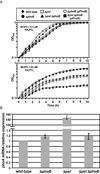PhoB regulates both environmental and virulence gene expression in Vibrio cholerae
- PMID: 20659293
- PMCID: PMC2981138
- DOI: 10.1111/j.1365-2958.2010.07310.x
PhoB regulates both environmental and virulence gene expression in Vibrio cholerae
Abstract
Vibrio cholerae is a facultative pathogen that thrives in two nutritionally disparate environments, aquatic and human small intestine. Phosphate (P(i) ) is an essential nutrient that is limited in aquatic ecosystems and of unknown availability in the small intestine. Here, we show that the P(i) (Pho) regulon, which is controlled by the P(i)-specific transporter (Pst) and two-component system PhoBR, is required for V. cholerae survival in both environments, though for differing reasons. While induction of P(i) acquisition systems including Pst is critical for survival in the aquatic environment, regulation of virulence genes by PhoB and not P(i) transport per se is required for colonization of the small intestine. We show that PhoB regulates virulence genes by directly controlling expression of a key upstream transcriptional regulator, tcpPH. Thus, the Pho regulon includes virulence genes and represents a diverse gene set essential to pathogenic V. cholerae throughout its life cycle.
© 2010 Blackwell Publishing Ltd.
Figures







Similar articles
-
A role for the PhoBR regulatory system homologue in the Vibrio cholerae phosphate-limitation response and intestinal colonization.Microbiology (Reading). 1999 Sep;145 ( Pt 9):2463-2475. doi: 10.1099/00221287-145-9-2463. Microbiology (Reading). 1999. PMID: 10517599
-
Vibrio cholerae ToxR downregulates virulence factor production in response to cyclo(Phe-Pro).mBio. 2013 Aug 27;4(5):e00366-13. doi: 10.1128/mBio.00366-13. mBio. 2013. PMID: 23982069 Free PMC article.
-
Fine-tuning control of phoBR expression in Vibrio cholerae by binding of phoB to multiple pho boxes.J Bacteriol. 2011 Dec;193(24):6929-38. doi: 10.1128/JB.06015-11. Epub 2011 Oct 7. J Bacteriol. 2011. PMID: 21984792 Free PMC article.
-
Expression of Vibrio cholerae virulence genes in response to environmental signals.Curr Issues Intest Microbiol. 2002 Sep;3(2):29-38. Curr Issues Intest Microbiol. 2002. PMID: 12400636 Review.
-
Regulation of virulence in Vibrio cholerae: the ToxR regulon.Future Microbiol. 2007 Jun;2(3):335-44. doi: 10.2217/17460913.2.3.335. Future Microbiol. 2007. PMID: 17661707 Review.
Cited by
-
A Mutant of Vibrio parahaemolyticus pirABVP (+) That Carries Binary Toxin Genes but Does Not Cause Acute Hepatopancreatic Necrosis Disease.Microorganisms. 2020 Oct 8;8(10):1549. doi: 10.3390/microorganisms8101549. Microorganisms. 2020. PMID: 33049933 Free PMC article.
-
Characterization of undermethylated sites in Vibrio cholerae.J Bacteriol. 2013 May;195(10):2389-99. doi: 10.1128/JB.02112-12. Epub 2013 Mar 15. J Bacteriol. 2013. PMID: 23504020 Free PMC article.
-
Comparative genomic, proteomic and exoproteomic analyses of three Pseudomonas strains reveals novel insights into the phosphorus scavenging capabilities of soil bacteria.Environ Microbiol. 2016 Oct;18(10):3535-3549. doi: 10.1111/1462-2920.13390. Epub 2016 Jul 7. Environ Microbiol. 2016. PMID: 27233093 Free PMC article.
-
Suppression of Virulence of Toxigenic Vibrio cholerae by Anethole through the Cyclic AMP (cAMP)-cAMP Receptor Protein Signaling System.PLoS One. 2015 Sep 11;10(9):e0137529. doi: 10.1371/journal.pone.0137529. eCollection 2015. PLoS One. 2015. PMID: 26361388 Free PMC article.
-
Staying Alive: Vibrio cholerae's Cycle of Environmental Survival, Transmission, and Dissemination.Microbiol Spectr. 2016 Apr;4(2):10.1128/microbiolspec.VMBF-0015-2015. doi: 10.1128/microbiolspec.VMBF-0015-2015. Microbiol Spectr. 2016. PMID: 27227302 Free PMC article. Review.
References
-
- Bahrani-Mougeot FK, Buckles EL, Lockatell CV, Hebel JR, Johnson DE, Tang CM, Donnenberg MS. Type 1 fimbriae and extracellular polysaccharides are preeminent uropathogenic Escherichia coli virulence determinants in the murine urinary tract. Mol Microbiol. 2002;45:1079–1093. - PubMed
Publication types
MeSH terms
Substances
Grants and funding
LinkOut - more resources
Full Text Sources
Molecular Biology Databases
Research Materials
Miscellaneous

